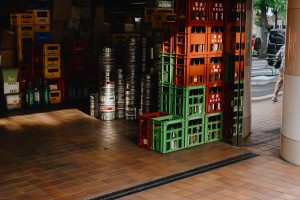Aegis & Co. aims to provide a basic explanation of the definition of property, plant and equipment, the criteria for recognition, as well as how it should initially and subsequently be measured in the financial statements in accordance with IAS 16 Property, Plant and Equipment and IFRS for SMEs Section 17 Property, Plant and Equipment.
What are Property, Plant and Equipment PP&E?
According to IAS 16 and IFRS for SMEs Section 17, property, plant and equipment are tangible assets held for use in the production or supply of goods and services, for rental to others, or for administrative purposes which are expected to be used during more than one period. Examples of PP&E that a business may possess include motor vehicles, machinery, land, buildings and office equipment.
Property, plant and equipment should not be confused with inventory. For example, if a company manufactures vehicles for sale, the vehicles are not PP&E, but inventory. However, if a company uses its vehicles for transporting goods to its customers, then the vehicles fall into the category of PP&E.

Recognition of PP&E
An item of property, plant and equipment should be recognised as an asset only when:
1) It is probable that future economic benefits associated with the asset will flow to the entity. This means that it is expected that cash flows or cash savings will be generated to a business from the use of the asset. In our example above, a motor vehicle utilised for transporting goods to customers will contribute to cash inflows into the company when customers receive their goods and pay.
2) The cost of the asset can be measured reliably. A reliable value of the asset should be attainable for recording so that PP&E is stated accurately in the financial statements and does not misrepresent the company’s financial status. This helps interested users of a company’s financial statements such as
investors or lenders to make informed decisions in relation to any transactions they wish to undertake with the entity. PP&E should initially be measured at its cost (explained further below). Continuing with our example of the motor vehicle, the cost of its acquisition can be reliably measured, and this asset provides future economic benefit to the entity. The motor vehicle therefore meets both recognition criteria and qualifies to be recognised as an item of PP&E in the financial statements.

Initial measurement of PP&E
As mentioned above an item of PP&E acquired should initially be measured and recorded in the financial statements at its cost. The cost includes the price paid for the asset and/ or all directly attributable costs involved in bringing the asset into its working condition. This includes such costs as site preparation, delivery costs, installation costs and in some cases borrowing costs.
For example let us suppose a soap company decided to acquire a new additional machine due to an increased demand for soap from consumers. It should capitalise (include in the asset’s cost) such costs as the cost of preparing the area where the machine will be placed (such as laying a foundation), the cost of delivering the components of the machine to the site, and the costs incurred by the technician(s) installing the machine so that it is in working condition.
Subsequent measurement of PP&E
In accordance with IAS 16 and IFRS for SMEs Section 17 after its initial measurement and recognition the asset should be measured and recorded at its cost less accumulated depreciation* and impairment losses* or a revalued amount less accumulated depreciation and impairment losses. It is normal that a business will spend subsequent expenditure on PP&E. For example a business may incur expenditure on replacing or repairing parts of a machine or enhancing its efficiency. The entity must determine whether to capitalise the subsequent spending on items of PP&E or record it as an expense on the statement of profit or loss account. *See the definition table below.
Subsequent expenditure on an asset should be capitalised based on whether the impact of the expenditure on the asset meets the recognition criteria of PP&E stated earlier. That is, it must lead to a probable flow of economic benefits into the entity and as a result enhance the economic benefits provided by the asset. It should also be measurable.
For example suppose the soap company mentioned earlier replaced a part of the machine that was purchased during the year. The part, which cost $15,000, was no longer functional. Later in the year they also installed an upgraded part which would double the speed of soap production. The upgraded part cost $30,000.
How should these items of expenditure be treated?
Solution:
1) The part replacement cost of $15,000 should be recorded as an expense in the statement of profit and loss as this purchase does not enhance future economic benefits which the entity will receive.
2) The $30,000 for the upgraded part should be capitalised and increase the cost of non-current assets in the statement of financial position as this purchase enhances future economic benefits which the entity will receive.
Definition Table
Depreciation is the allocation of the cost of an asset over its useful life. It also reflects the reduction in the value of an asset due to wear and tear with the passage of time.
An asset is impaired when its recoverable value is lower than the value of the asset recorded on the statement of financial position or balance sheet. The recoverable amount is the higher of the market value less cost to sell the asset and its value in use. “Value in use is determined by estimating future cash inflows and outflows to be derived from the use of the asset and its ultimate disposal, and applying a suitable discount rate to these cash flows”. – Kaplan Publishing Financial Reporting (FR) Study Text September 2019 to June 2020 Sittings.
SUMMARY TABLE
Property, plant and equipment are tangible assets held for use in the production or supply of goods and services, for rental to others, or for administrative purposes which are expected to be used during more than one period.
An item of property, plant and equipment should be recognised as an asset only when it is probable that future economic benefits associated with the asset will flow to the entity and the cost of the asset can be measured reliably.
After its initial measurement and recognition the asset should be measured and recorded at its cost less accumulated depreciation and impairment losses or a revalued amount less accumulated depreciation and impairment losses.
Subsequent expenditure on an asset should be capitalised only when it enhances the future economic benefits provided by the asset.

Written by Kerron Duncan





